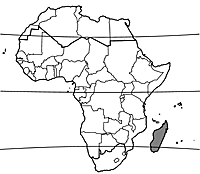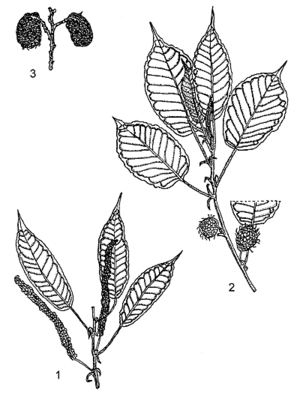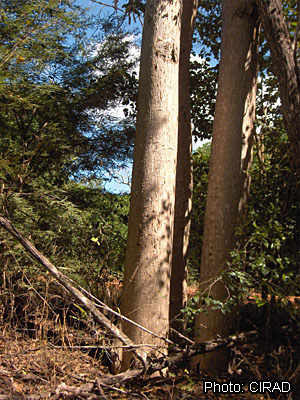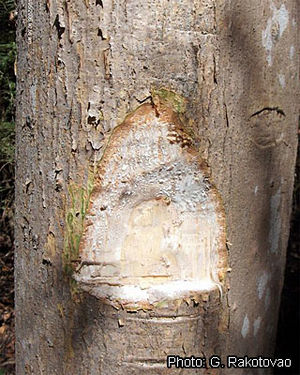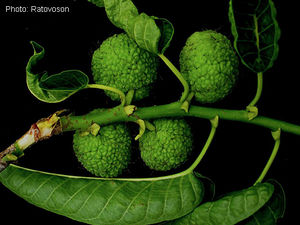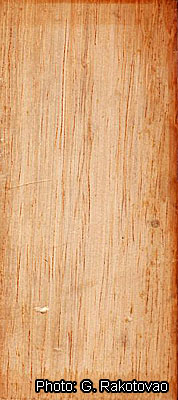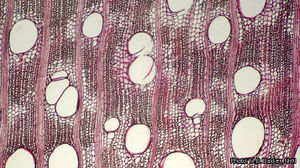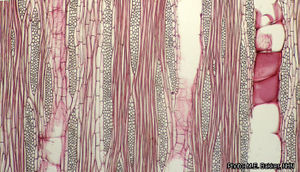Broussonetia greveana (PROTA)
Introduction |
Broussonetia greveana (Baill.) C.C.Berg
- Protologue: Bull. Jard. Bot. Etat 47(3–4): 356 (1977).
- Family: Moraceae
Synonyms
- Chlorophora greveana (Baill.) Leandri (1948),
- Allaeanthus greveanus (Baill.) Capuron (1972).
Origin and geographic distribution
Broussonetia greveana occurs in Madagascar, where it occurs throughout the western part of the country, and in Mayotte.
Uses
The wood (trade names: vory, somely) is excellent for framing and construction. It is used for light interior joinery and cabinet work, ceilings, panelling, interior trim, boxes, crates, blockboard, laminated board, peeled and sliced veneer for non-decorative purposes, core stock and particle board. The wood is traditionally used for construction, boat building, canoes, carts, and bars of xylophones. It is also used as fuelwood. The bark is used for clothing. A decoction of the bark is considered restorative and anthelmintic.
Production and international trade
The wood of Broussonetia greveana is much sought after for local use in western Madagascar. In 1987 the log volume equivalent of boards sold on the market of Morondave was estimated at 6200 m³. The wood has probably never been exported.
Properties
The heartwood is creamy to brown; it is clearly demarcated from the 8–12 cm wide, very pale sapwood. The wood is lightweight, with a density of 400–500 kg/m³ at 12% moisture content. It dries easily and rapidly, with low risk of distortion and checking. Boards 25 mm thick take 1–2 months to air dry, boards 40 mm thick 5–6 months. The rates of shrinkage are low to moderate, from green to oven dry 2.9–3.7% radial and 5.8–6.6% tangential. Once dry, the wood is stable in service. The wood is soft. At 12% moisture content, the modulus of rupture is 81–104 N/mm², modulus of elasticity 6800–8200 N/mm², compression parallel to grain 34–43 N/mm², shear 3–4 N/mm², cleavage 16–17 N/mm and Chalais-Meudon side hardness 1.3–1.9. The wood saws, peels and works easily with ordinary tools, and does not have a marked blunting effect on tools. It does not split on nailing and screwing, and it holds nails and screws well. Gluing properties are good. The wood polishes, waxes, varnishes and paints well. The heartwood is moderately resistant to fungal attacks, fairly resistant to termites, and resistant to dry wood borers. The sapwood has a low durability and should be removed or be treated with preservatives before the wood is used. The heartwood is only moderately permeable to impregnation.
Description
- Dioecious, deciduous or sometimes evergreen, medium-sized tree up to 25 m tall, white latex present in all parts, rapidly turning pale brown on exposure; bole branchless for up to 12 m, up to 80(–150) cm in diameter, generally straight; bark surface yellowish pink, longitudinally fissured, with rows of brown lenticels, flaking off in thin layers, inner bark with yellowish and hard outer part and white and very fibrous inner part; crown spreading; branchlets with caducous greyish hairs.
- Leaves alternate, simple; stipules up to 16 mm × 3.5 mm, membranous, more or less crumpled, late-caducous with clear scars; petiole slender, 5–40 mm long, grooved above, hairy; blade elliptical to oblong or lanceolate, 2–20 cm × 0.5–8 cm, rounded or slightly cordate at base, acuminate at apex, papery, lower surface of young leaves greyish hairy, pinnately veined with 6–20(–25) pairs of lateral veins.
- Inflorescence an axillary catkin; male inflorescence towards the tip of the branch, cylindrical, 1–12 cm long, reddish, many-flowered, peduncle 0.5–2 cm long, densely white-hairy; female inflorescence globose to oblongoid, c. 0.5 cm in diameter, peduncle 0.5–1.5 cm long, white-hairy.
- Flowers unisexual; male flowers sessile, with 4–5 free perianth segments and 4 stamens; female flowers covered by bracts, perianth 2–4-lobed, ovary superior, c. 1 mm long, stigmas 2, one of them strongly reduced and the other up to 7 mm long.
- Fruit a 1-seeded oblongoid drupe 4–5 mm long, many together arranged in a globose to oblongoid infructescence 1.5–2.5(–3) cm in diameter.
- Seed 2–3 mm long.
Other botanical information
Broussonetia comprises 8 species, of which 7 occur in tropical, subtropical and warm temperate regions of Asia, and 1 in Madagascar.
Anatomy
Wood-anatomical description (IAWA hardwood codes):
- Growth rings: 2: growth ring boundaries indistinct or absent.
- Vessels: 5: wood diffuse-porous; 13: simple perforation plates; 22: intervessel pits alternate; 25: intervessel pits small (4–7 μm); 26: intervessel pits medium (7–10 μm); 30: vessel-ray pits with distinct borders; similar to intervessel pits in size and shape throughout the ray cell; 31: vessel-ray pits with much reduced borders to apparently simple: pits rounded or angular; 42: mean tangential diameter of vessel lumina 100–200 μm; (46: ≤ 5 vessels per square millimetre); 47: 5–20 vessels per square millimetre.
- Tracheids and fibres: 61: fibres with simple to minutely bordered pits; 66: non-septate fibres present; (68: fibres very thin-walled); 69: fibres thin- to thick-walled.
- Axial parenchyma: 79: axial parenchyma vasicentric; 80: axial parenchyma aliform; 81: axial parenchyma lozenge-aliform; (83: axial parenchyma confluent); 91: two cells per parenchyma strand; 92: four (3–4) cells per parenchyma strand.
- Rays: (97: ray width 1–3 cells); (98: larger rays commonly 4- to 10-seriate); (102: ray height > 1 mm); 106: body ray cells procumbent with one row of upright and/or square marginal cells; 107: body ray cells procumbent with mostly 2–4 rows of upright and/or square marginal cells; (110: sheath cells present); 115: 4–12 rays per mm.
- Secretory elements and cambial variants: 132: laticifers or tanniferous tubes.
- Mineral inclusions: 136: prismatic crystals present; 137: prismatic crystals in upright and/or square ray cells; (141: prismatic crystals in non-chambered axial parenchyma cells).
Growth and development
The availability of abundant water favours regeneration. Trees reach a height of 4–6 m when 7 years old. In general, flowering is in (June–)September–December, and fruiting in November–January(–February). In the dry, deciduous Kirindy forest near Morondava Broussonetia greveana bears leaves during 3–4 months, from November to March. Here, flowering is in October–November, coinciding with the appearance of new leaves, and fruits are ripe in January–February. It flowers and fruits regularly, every year or at least once every 2 years. The fruits are much appreciated by lemurs and parrots, which certainly disperse the seeds.
Ecology
Broussonetia greveana occurs up to 800 m altitude, in all forest types of western Madagascar. In deciduous dry forest it is part of the dominant forest layer. It mainly occurs on slopes. In the much drier southern part of Madagascar, it is confined to locations along water courses. In Mayotte it grows in all forest types, from humid to dry.
Propagation and planting
Broussonetia greveana is now commonly planted in the Morondava region of Madagascar. The fruits are harvested when they are ripe and juicy. The seeds are extracted from the pulp by repeated washing, and they are dried in the shade. The 1000-seed weight is about 5 g. The seeds store poorly and are preferably sown soon after collection. They are sown in the shade, and the germination rate is about 45%. After germination, the plants are pricked out at a spacing of 10 cm × 10 cm. After a year in the nursery they are 50–100 cm tall and ready to be planted out. Best results are obtained by planting out leafless plants during the dry season, which gives more than 90% success, against less than 80% success for planting out in the rainy season. Seedlings attain a height of up to 1 m in 2 years under shade, compared to only 40 cm in more exposed conditions.
Diseases and pests
In forest north-east of Morondava it has been reported that the Malagasy giant rat (Hypogeomys antimena), an endangered rodent, feeds on young Broussonetia greveana plants, and that these should be protected.
Genetic resources
In view of its rather wide distribution, its plasticity in climatic and edaphic requirements, and the fact that it is one of the more widely planted tree species in western Madagascar, Broussonetia greveana does not seem immediately threatened with genetic erosion. Nevertheless, observations showed a rapid decrease in sales of boards of this species on the Morondava markets during the 1990s, accompanied by a reduction of seed-bearing trees in the forest as well as less abundant natural regeneration. Moreover, its habitat is under strong pressure from forest clearing for agriculture and livestock keeping.
Prospects
Broussonetia greveana is highly appreciated for its wood, which locally results in overexploitation, disappearance of its wood from markets, and reduced natural regeneration. The species deserves attention because the wood has interesting technological characteristics, and propagation and planting techniques are becoming mastered. Techniques of propagation by cuttings deserve to be investigated.
Major references
- Berg, C.C., 1977. Revisions of African Moraceae (excluding Dorstenia, Ficus, Musanga and Myrianthus). Bulletin du Jardin Botanique National de Belgique 47(3–4): 267–407.
- Capuron, R., 1966. Etudes sur les essences forestières de Madagascar : vory ou somely (Allaeanthus greveanus (Baillon) R. Cap.). Centre Technique Forestier Tropical, Section de Madagascar, Tananarive, Madagascar. 11 pp.
- Ganzhorn, J.U. & Sorg, J.-P. (Editors), 1996. Ecology and economy of tropical dry forest in Madagascar. Primate Report 46-1, special issue. Erich Goltze, Göttingen, Germany. 382 pp.
- Guéneau, P., 1971. Bois de Madagascar. Possibilités d’emploi. Centre Technique Forestier Tropical, Antananarivo, Madagascar. 75 pp.
- Guéneau, P., Bedel, J. & Thiel, J., 1970–1975. Bois et essences malgaches. Centre Technique Forestier Tropical, Nogent-sur-Marne, France. 150 pp.
- Sallenave, P., 1971. Propriétés physiques et mecaniques des bois tropicaux. Deuxième supplément. Centre Technique Forestier Tropical, Nogent-sur-Marne, France. 128 pp.
Other references
- Berg, C.C., 1982. The reinstatement of the genus Milicia Sim (Moraceae). Bulletin du Jardin Botanique National de Belgique 52(1–2): 225–229.
- Berg, C.C. & Hijman, M.E.E., 1989. Moraceae. In: Polhill, R.M. (Editor). Flora of Tropical East Africa. A.A. Balkema, Rotterdam, Netherlands. 95 pp.
- Guéneau, P. & Guéneau, D., 1969. Propriétés physiques et mécaniques des bois malgaches. Cahiers scientifiques No 2, Centre Technique Forestier Tropical, Nogent-sur-Marne, France. 51 pp.
- Capuron, R., 1972. Contributions à l’étude de la flore forestière de Madagascar. Adansonia, séries 2, 12(3): 375–388.
- Debray, M., Jacquemin, H. & Razafindrambao, R., 1971. Contribution à l’inventaire des plantes médicinales de Madagascar. Travaux et Documents No 8. ORSTOM, Paris, France. 150 pp.
- Ganzhorn, J.U., 1995. Cyclones over Madagascar: fate or fortune? Ambio 24(2): 124–125.
- InsideWood, undated. [Internet] http://insidewood.lib.ncsu.edu/search/. May 2007.
- Pascal, O., Labat, J-N., Pignal, M. & Soumille, O., 2001. Diversité, affinités phytogéographiques et origines présumées de la flore de Mayotte (Archipel des Comores). Systematics and Geography of Plants 71: 1101–1123.
- Perrier de la Bâthie, H. & Leandri, J., 1952. Moracées (Moraceae). Flore de Madagascar et des Comores (plantes vasculaires), famille 55. Firmin-Didot et cie., Paris, France. 76 pp.
- Schatz, G.E., 2001. Generic tree flora of Madagascar. Royal Botanic Gardens, Kew, Richmond, United Kingdom. 477 pp.
Sources of illustration
- Berg, C.C., 1977. Revisions of African Moraceae (excluding Dorstenia, Ficus, Musanga and Myrianthus). Bulletin du Jardin Botanique National de Belgique 47(3–4): 267–407.
Author(s)
- D. Louppe, CIRAD, Département Environnements et Sociétés, Cirad es-dir, Campus international de Baillarguet, TA C-DIR / B (Bât. C, Bur. 113), 34398 Montpellier Cedex 5, France
Correct citation of this article
Louppe, D., 2008. Broussonetia greveana (Baill.) C.C.Berg. In: Louppe, D., Oteng-Amoako, A.A. & Brink, M. (Editors). PROTA (Plant Resources of Tropical Africa / Ressources végétales de l’Afrique tropicale), Wageningen, Netherlands. Accessed 6 March 2025.
- See the Prota4U database.

